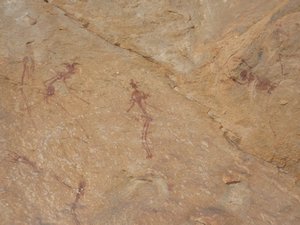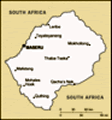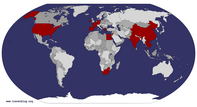Advertisement
Published: August 4th 2010

 San (Bushman) Cave Painting
San (Bushman) Cave Painting
These paintings are 400 years old and still visible, A mixture of animal blood and an unknown substance was used to create them.We spent the last week in Lesotho which is a small kingdom embedded in South Africa. It is roughly circular, about 150 miles in diameter. Although independent, it is closely tied to South Africa; for instance, its currency (called a loti) is tied one for one with the rand, and inside Lesotho rands are used interchangeably with maloti (maloti is the plural of loti).
Journey to Losotho
It has been said that getting there is half the adventure and that was certainly true of our journey to Lesotho.
We arose at 5am and quickly dressed and packed; our taxi was waiting for us at 5:30. The taxi driver knew exactly what bus we needed and dropped us off in the right place. We went up to the bus departure point and there were very many buses. We had just figured out we needed gate 10 and where it was when a nice lady came up and asked if we needed help. At least I think that is what she asked—I don’t know what language she was speaking. I just said Maseru (the main border city and capital of Lesotho) and she confirmed the bus we picked out was

 Bosotho Museum
Bosotho Museum
A classic Bosotho house.indeed the right one.
The bus left promptly at 6 (after pausing for a few stragglers) then headed out. The landscape was not very interesting (think Kansas). We had a few stops and hawkers would board the bus selling food; it looked interesting but we didn’t buy any. I slept the last hour so was confused when we got to Maseru. I had assumed we would go through immigration on the bus but the bus pulled into the parking lot on the SA side of the border.
So we got off and walked through SA immigration then through Lesotho immigration. On the other side it was chaotic. One taxi driver approached us offering a ride but when he did not understand “tourist information center” we decided to walk…it was about a mile. On the way, children waved to us, people returned my smiles and taxi drivers kept asking if we wanted a ride. We even passed the US Embassy which was guarded like a fortress.
Without any problem, we reached the tourist information center. We told the ladies what we were looking for and they recommended
Malealea Lodge . She gave us the number for the lodge, directions to

 Typical Village
Typical Village
This is the village across the valley from Ribaneng.the ATM and details about how to use the mini-bus taxis (MBT) to get to Malealea.
So we caught a regular taxi to take us to the MBT stand. The drive took 20 minutes mostly because the driver spent the time trying to get other people into the taxi even though we had already paid the fare. He did squeeze two more people in for awhile.
I need to describe MBT’s for you to get the right impression. To create an MBT, start with a shell similar to a mini-van. Put bench seats in the front and four bench seats in the back. Leave a small aisle so people can get in and out but include a folding seat so someone can sit in that aisle. The result is a mini-van that seats 17 plus the driver. Needless to say, it is tight. At the MBT stand, I had expected to find a MBT labeled Malealea but we had no such luck. One driver convinced us he would take us half way and then we could catch another MBT for the rest. Now understand that MBT’s are privately owned and so the driver gets paid by the passengers;

 Motsekuoa
Motsekuoa
Two fellows who allowed Beth to take their picture. They were delighted to see their images displayed back to them on the digital camera. Note how they are wearing tribal blankets, a tradition among the Basotho people.he (so far always a he) is incentivized to carry as many passengers as possible…getting there quickly is not a consideration. There are places in the world where simple economics trumps convenience. So we stopped frequently and for lengthy periods as the helper worked to round up more passengers. This continued all the way to the point where we got off. This ride cost R19 each (about $3).
The most interesting sight along the way was the cattle herders. They were grazing herds of up to 20 cattle with one man (always an adult male) standing guard. Almost all of the men were wearing a beautiful blanket tied on their right shoulder covering their left arm.
At our transfer point, folks were very helpful showing us where to stand to catch the bus to Malealea and there we stood…for over an hour. Several MBTs passed us but they were already full, even by Lesotho standards.
John stayed put but I wandered past the fruit stands and the roasted chicken foot seller, through the general store and then back to buy two oranges (R1 = 15 cents each).
Now try to understand how much we stood out.

 Motsekuoa
Motsekuoa
We transferred between minibus taxis (combis) in this town. I had seen exactly one white person since we were dropped off by the taxi at 5:30am. We were using the transportation system of the lower class and they are all black. Plus our backpacks are pretty unusual. But because we stood out, people were very friendly and helpful. They saw me taking pictures and asked me to take their picture. Then they were impressed with being able to view the picture on the screen.
Finally, a MBT going to Malealea arrived and we piled in. After waiting about 20 minutes for more passengers we set out and headed the wrong direction. We sat tight and quickly realized the driver was just putting gas in the vehicle. Then we headed for Malealea. This bus was tighter than the previous one so we had to keep our bags on our laps. As we were initially boarding, one woman saw us and decided to sit in the front seat rather than be crammed in with us. The man who did sit next to me was drunk and did not seem able to grasp that I could not understand his language.
We proceeded down a bumpy road like this for 26km.

 Birds of a feather...
Birds of a feather...
The peacocks gathered on the roof of our hut.The road was actually recently paved so in pretty good shape but the shocks on the MBT were long gone so it felt bumpy. Finally the pavement ended and there waited another MBT going to Malealea so we were transferred to it. The R15 each we paid to the second MBT also covered the third. And so we headed up a pass on a very bumpy, rutted dirt road. After seven km of that, we arrived and just as the lady at the TI promised, we were right in front of Malealea Lodge.
Malealea Lodge
The lodge was a perfect compromise between western needs and African availabilities. We walked in the gate and were met by the gatekeeper, Eric. He took us through the lovely grounds to the Reception office where we met Michael. Our hut has an en suite bath with a shower and flush toilet (unheard of in a locals hut) but twin beds. It is only R280 ($35) per night. It has a thatched roof, is unheated and only has electricity between 5pm and 9:30pm.
The grounds are in a fenced compound and the facility can host about 100 guests. There are peacocks and

 Rampi
Rampi
Our trek guide Rampi on a horse named "Heavy." peahens wandering about and up to four peacocks were roosting on our roof. There are at least five mellow dogs wandering about and we are on the top of a hill so the views are great. The facility has a bar and a dining room that serves three meals a day (not included in the room rate). There is also a kitchen where guests can cook their own meals.
Trek to Ribaneng
One of the reasons the TI suggested Malealea Lodge is because we asked about homestays, so we took a two day trek to the village of Ribaneng and stayed one night in a local hut.
Our guide, Rampi, came to our room to help us with our equipment. Then we set off hiking across the fields while Rampi went to get his sleeping bag and food from his house. (His food was a bag of rolls…nothing else.)
The conditions were great for hiking…cool and partly sunny going downhill on a nice dirt road. The first challenge was to walk down to the river then up to Ha Graffis (Graffis Village). There we had our first encounter with the friendly children. They will say “bye-bye”

 Bosotho children
Bosotho children
Two Bosotho children saying "bye-bye" to us in greeting.as greeting and sometimes “hello.” I have also seen thumbs up and sometimes they ask for sweets (which we are not supposed to give them).
Next we set off across the fields. I remember listening to a tenor cowherd singing to himself and saw a woman with four children washing clothes in a very small stream.
We stopped for lunch at a dry spot with a beautiful view of the mountains and fields. Then we continued on and entered Ribaneng Valley. The first village we came to in the valley had solar panels that were used to pump water for that village and a neighboring one. Rampi pointed out that all villages have a tap for clean water; one of the activities of the government. We passed by some shops or “pubs” that could be identified by the flags they were flying…white for moonshine, yellow for wine, orange for fruit and vegetables.
All this time, Rampi was following on his horse (named “Heavy”) and leading the packhorse carrying our gear. Having only light daypacks made this trip very easy.
After several miles, we slowly dropped down to the river, crossed it, and headed up to the

 Little Girl Grinding Dirt
Little Girl Grinding Dirt
This little girl is using her mother's grinding stones to practice grinding corn. This is easily Beth's favorite picture so far.village of Ribaneng. The chief for the area lives in Ribaneng and the hut we stayed in is right next to his. Each Chief governs an area about 400 square miles and each village has a sub-chief or headman to govern that village. For instance, Malealea is an area with 14 villages ranging from 50 to 450 people in each village. The chief lives in the same village as Malealea Lodge. The role of chief is passed father to son although women can be an acting chief while a son grows up.
We arrived in Ribaneng about four o’clock and got everything set up. It was disappointing how disinterested the ladies in the Chief’s hut were. They weren’t unfriendly; just simply tolerant of our presence. Hellos and smiles went unnoticed. The children, however, became interested in me when I got out the camera and started taking pictures of them. A couple of girls were using the two grinding stones to grind pretend corn (actually dirt).
Let me describe the hut we stayed in. It is round and about 15 feet in diameter. The outside is made of stone and the inside is plastered with a reddish brown mud.

 Teboha and his father
Teboha and his father
We had dinner with Teboha and his father one evening. Here they are wearing the traditional Basotho hat.The roof was made of grasses and was pointed with the point about 12 feet high. Inside was a table with a two burner stove and about 10 mattresses. The pack horse had carried the gas for the stove. One of the women from the chief’s hut brought us a bucket of water; it was a big plastic 5 gallon industrial bucket that used to hold paint. There was no plumbing, heat or lights.
After standing around the hut for a while just people watching, we decided to cook dinner. It was then that we realized our plans for spaghetti were not going to work because we forgot to buy the spaghetti. In addition, what we thought was tomato sauce was actually pilchers (a fish) in tomato sauce. Some rapid reassessment of food plans led us to have baked beans, chakalaka (a type of spicy mixed veggie), and fresh tomatoes for dinner. I had to peel the tomatoes because the store had simply written the price on the tomatoes in ballpoint pen.
After eating, it was starting to get dark so we went to use the privy (filthy but with a beautiful view). We went back to our

 Mpo and John
Mpo and John
John with our young guide to the waterfall.hut and got ready for bed. Once we were in bed and tucked in we checked the time and it was only 6:30 pm (it is winter down here). I sat and listened to the sounds of the village. The music continued until the wee hours of the morning. The ladies next door continued to make their meal and, I assume ate dinner at some point. There were roosters crowing and packs of dogs howling. People walked past on a regular basis. On several instances, I almost got up to go outside and watch but my sleeping bag was too warm and the night air was too chilly.
I slept as I normally do when I sleep on the ground and at least we had 12.5 hours to rest.
We pulled ourselves out of bed at about 7:15. Breakfast was Milo (like Nestle Quik), fruit cocktail, and a white roll. We got everything packed up and then Rampi introduced us to our waterfall guide, Mpo. Mpo was about13 years old and wearing rubber boots, a blanket (in lieu of a coat) and a stocking cap. We set off across the hillside at a reasonable pace. After about an hour,
we could see Ribaneng Falls. It’s a very high falls, maybe 300 feet, but because it’s winter, the flow is pretty low. Only along this part of the journey have we seen the natural vegetation of the region. All of the rest of the walk has been through cultivated lands. The natural vegetation is a mixture of low bushes; there are very few trees. The bushes reach to about five feet in height at the tallest.
As we were walking back from the falls we started to hear drums, chanting, and keening or ululating. We asked Mpo what it was, but his response was “I don’t speak English”. As we got back to our hut, Mpo pointed out that the people making the sounds were approaching the village. When we got to the village, Rampi told us that this was the first day of Initiation School for the boys and this was a ceremony welcoming them. I wanted to take a picture and record the chanting but I asked Rampi first and he said it wasn’t appropriate. “Too secret” he said. So at about 10:30, we left the village and started our trek back.
The countryside we were walking through is very similar to the American Southwest with lots of mesas having been carved out by rivers. Our route back to the lodge was about 12 miles so adding the 3 miles to and from the waterfall made one long day. But the trip was definitely worth it.
Return to South Africa
After returning from the trek we spent a day resting then made our way back to South Africa via the MBTs. Next stop: Durban
Advertisement
Tot: 0.214s; Tpl: 0.013s; cc: 10; qc: 49; dbt: 0.1043s; 1; m:domysql w:travelblog (10.17.0.13); sld: 1;
; mem: 1.2mb











Susan Craig
non-member comment
Wonderful!
Beth and John, Thank you so much for the wonderful travel log. I can imagine it so well, and am amazed at your adventures. Please be safe and all our Sequim love to you. Susan